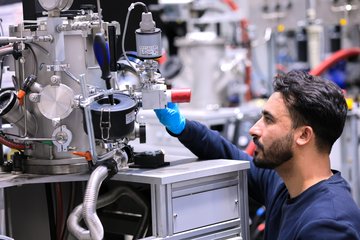All genres
541.
Journal Article
Computationally efficient and quantitatively accurate multiscale simulation of solid-solution strengthening by ab initio calculation. Acta Materialia 85, pp. 53 - 66 (2015)
542.
Journal Article
Thermal dissolution mechanisms of AlN/CrN hard coating superlattices studied by atom probe tomography and transmission electron microscopy. Acta Materialia 85, pp. 32 - 41 (2015)
543.
Journal Article
Nanolaminate transformation-induced plasticity-twinning-induced plasticity steel with dynamic strain partitioning and enhanced damage resistance. Acta Materialia 85, pp. 216 - 228 (2015)
544.
Journal Article
Shear-flow-controlled mode selection in a nonlinear autocatalytic medium. Physical Review E 91 (2), 022913 (2015)
545.
Journal Article
Effects of Ru on elemental partitioning and precipitation of topologically close-packed phases in Ni-based superalloys. Scripta Materialia 101, pp. 44 - 47 (2015)
546.
Journal Article
Mechanisms of subgrain coarsening and its effect on the mechanical properties of carbon-supersaturated nanocrystalline hypereutectoid steel. Acta Materialia 84, pp. 110 - 123 (2015)
547.
Journal Article
Segregation of boron at prior austenite grain boundaries in a quenched martensitic steel studied by atom probe tomography. Scripta Materialia 96, pp. 13 - 16 (2015)
548.
Journal Article
Advanced scale bridging microstructure analysis of single crystal Ni-base superalloys. Advanced Engineering Materials 17 (2), pp. 216 - 230 (2015)
549.
Journal Article
Grain Boundary Segregation in Fe–Mn–C Twinning-Induced Plasticity Steels Studied by Correlative Electron Backscatter Diffraction and Atom Probe Tomography. Acta Materialia 83, pp. 37 - 47 (2015)
550.
Journal Article
Linking atomistic, kinetic Monte Carlo and crystal plasticity simulations of single-crystal tungsten strength. GAMM-Mitteilungen 38 (2), pp. 213 - 227 (2015)
551.
Journal Article
On the room temperature deformation mechanisms of a Mg–Y–Zn alloy with long period stacking ordered structures. Acta Materialia 82, pp. 414 - 423 (2015)
552.
Journal Article
Atom probe tomography study of internal interfaces in Cu2ZnSnSe4 thin-films. Journal of Applied Physics 118 (9), 095302 (2015)
553.
Journal Article
Detection of Cu2Zn5SnSe8 and Cu2Zn6SnSe9 phases in co-evaporated Cu2ZnSnSe4 thin-films. Applied Physics Letters 107 (17), 172102 (2015)
554.
Journal Article
A novel roll-bonding methodology for the cross-scale analysis of phase properties and interactions in multiphase structural materials. International Journal of Materials Research 106 (1), pp. 3 - 14 (2015)
555.
Journal Article
The maximum separation cluster analysis algorithm for atom-probe tomography: Parameter determination and accuracy. Microscopy and Microanalysis 20 (6), pp. 1662 - 1671 (2014)
556.
Journal Article
Integrated experimental–simulation analysis of stress and strain partitioning in multiphase alloys. Acta Materialia 81, pp. 386 - 400 (2014)
557.
Journal Article
Strain localization and damage in dual phase steels investigated by coupled in-situ deformation experiments and crystal plasticity simulations. International Journal of Plasticity 63, pp. 198 - 210 (2014)
558.
Journal Article
Deformation mechanisms in an austenitic single-phase duplex microstructured steel with nanotwinned grains. Acta Materialia 81, pp. 487 - 500 (2014)
559.
Journal Article
Intrinsic and extrinsic size effects in the deformation of amorphous CuZr/nanocrystalline Cu nanolaminates. Acta Materialia 80, pp. 94 - 106 (2014)
560.
Journal Article
In situ observation of collective grain-scale mechanics in Mg and Mg-rare earth alloys. Acta Materialia 80, pp. 77 - 93 (2014)











